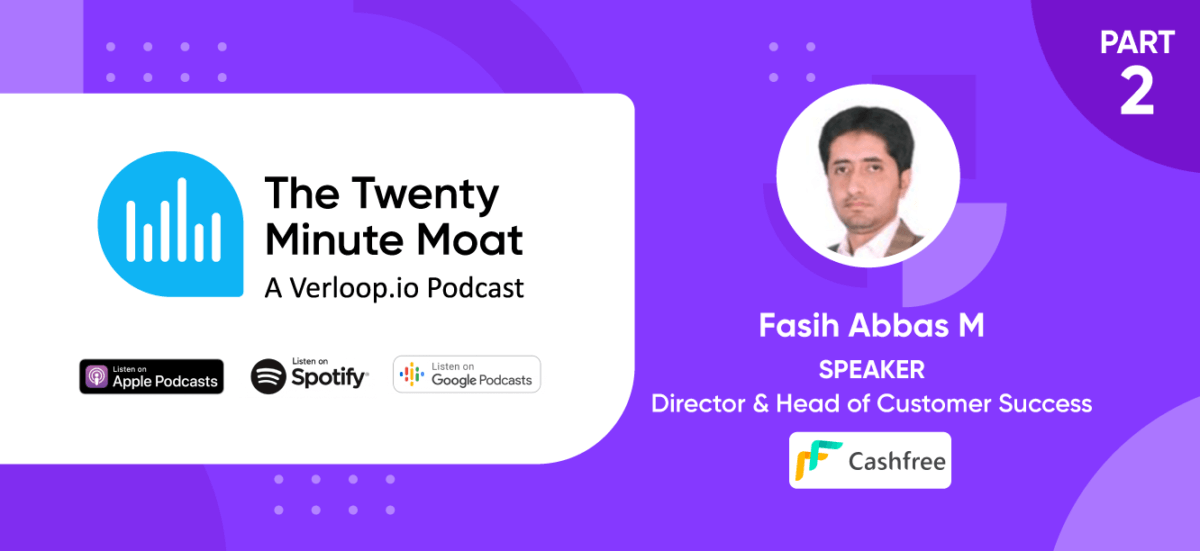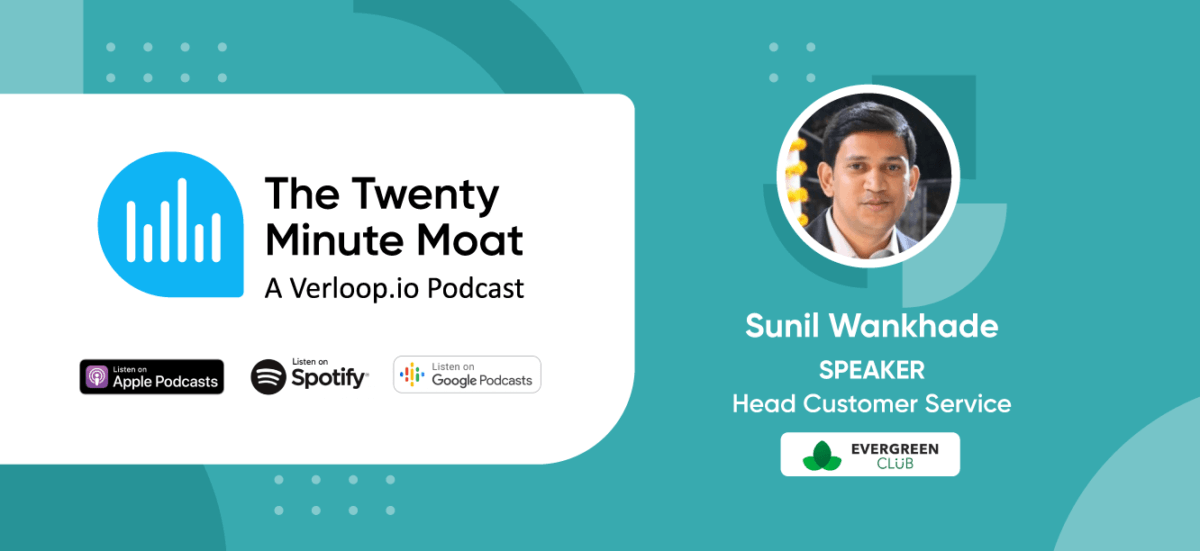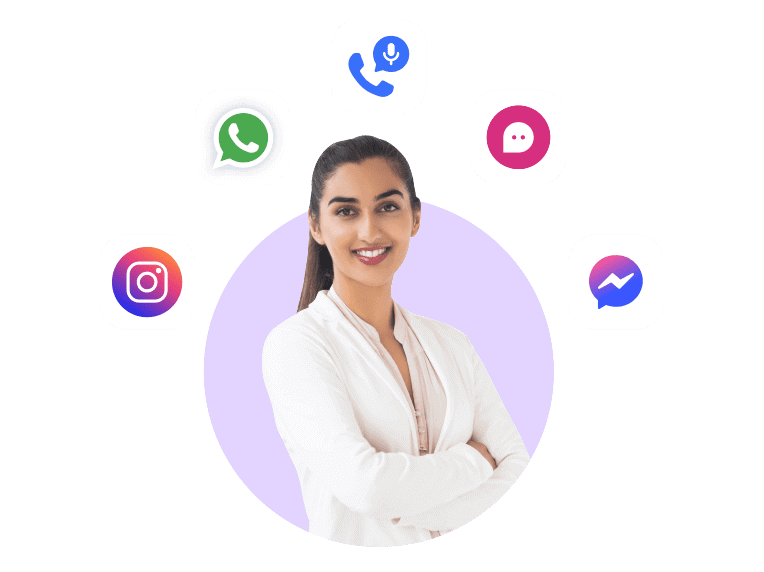Duration 13:53
Guest Speaker
Industry
Ed-tech
Arun Jagannathan, over the past decade, has worn multiple hats as a tutor, an entrepreneur, and a technology manager. He started his career as a techie moving into a project management role before plunging full-time into entrepreneurship in 2011 when he co-founded CrackVerbal – currently India’s leading GMAT test prep and MBA Applications Consulting company. “English for India” is his second entrepreneurial venture, in which he helps companies meet their business outcomes through better employee communication. Arun likes to read online on digital marketing and productivity. He also mentored some startups on a pro bono basis.
We cover:
- [01:32] How crucial is customer support at CrackVerbal?
- [03:32] What impact did the pandemic have on customer support?
- [05:04] How has customer support as a space evolved?
- [06:41] What channels do customers prefer interacting with brands?
- [08:32] Impact of conversational AI on customer support
Podcast Transcript
In this personalising customer support podcast, we have Arun Jagannathan as our podcast guest and Siddharth Sharma as our podcast host.
Siddharth Sharma
Today I have Arun, who’s the co-founder and CEO of CrackVerbal. I have followed Arun super closely since he co-founded CrackVerbal and he’s a bundle of infectious energy.
For folks who don’t know Arun, here’s a short brief. Over the past decade, he has worn multiple hats as a tutor, entrepreneur and technology manager.
While his career started as a techie, he plunged full time into entrepreneurship in 2011, where he co-founded CrackVerbal, currently India’s leading GMAT test prep and MBA applications consulting company.
Arun, you know, for our listeners, would you be kind enough to share a bit more about yourself and CrackVerbal?
Arun Jagannathan
Thank you, Siddharth. Thank you for inviting me here. So, I was a techie and, I think, at some point, I had bad career advice.
And at that same point I just realized that should be the kind of mission that I need to have. So after spending about a decade in the IT industry, I… uh… became a…a…. entrepreneur.
To be honest, it was an education entrepreneur. It became a Tech a lot lot, lot, lot later. At CrackVerbal, we help students with the GMAT prep and we also help them with the admission consulting part.
And, you know, it’s been a journey for about 10 years. And, I also have co-founded another company called ‘English for India’ which is also in education, but it’s in a B2B market where we do communication training for companies.
[01:32] Siddharth Sharma
Great. I think you are now a serial entrepreneur. Like… every time I hear about you, you have another organization against your name.
Alright. So let’s deep dive into the topic for today, right? How important do you think is customer support in general and at CrackVerbal?
Arun Jagannathan
So, I think one of the things that… you know, especially on… you know, am… am… you know, my consists from the education world.
And post COVID, you know, there has been this talk of somehow translating everything that is brick and mortar onto an online version. And since I’ve had the… you know, the advantage of seeing both sides, so we have had three centers in Bangalore and… pre-COVID, and now we have gone completely online.
So, I think one of the biggest challenges that we have faced or we have seen is that when there is a touch and feel factor, when a student comes to approach you… uh… in a centre, whereas the way he approaches online is very different.
Because when you approach a person, the human nature is to… you know, have a conversation and… you know, there is that… there’s that lot of nonverbal cues that also that go into it.
Then COVID hit and we had to… you know, shut down our three centers and we actually transitioned to a completely online program.
And now, my support person is an email address. My support person is on the other side of the interface and if the human context of a teacher does not come in… in the support… you know, interaction that we have, I think the whole essence specifically in education gets lost.
Because a student may call us a week before the test and he may have one question
And this may be a question that could be a not a deal-breaker, but in the mind of the student, he just wants to have someone who he can talk to immediately.
Someone with whom he can… you know, kind of get a little bit more clarity and also the… kind of the touch part to the tech. So that’s… that’s been our, uh…
you know, learning from the pre-COVID and the post-COVID phenomena as far as customer experience is concerned.
[03:31] Siddharth Sharma
Got it. And you talked about the learning, right, and I would like a little bit more deep dive into this.
What were the initial challenges your team had seen while handling support queries? And this is like pre-COVID and you can break it into pre and post COVID and how typically were they resolved?
Arun Jagannathan
So, I think one of the parts of the touch factor is, you know, you can have very high touch,
but what we also experienced over there was a lack of… you could say, we weren’t able to clearly spot metrics.
So if we have support tethered to a particular place and you expect that students… let’s say, come over or …they kind of clarify the doubts, It’s a very different way in which you… kind of, measure things.
So the first thing that… I think, was a challenge for us is how do we measure success, right.
How do we measure customer interaction? One is… we could put one quantitative data points like number of… you know, queries they resolved or… the time that they put on the phone.
But, I think there is a softer quality to think that also comes into play. Which is- was the student feeling more confident after he had that interaction. And it could be support as simple as getting access to the material. Or it could be something more complex where… you know, he’s asking for some kind of an advice.
And wants to be put in touch with the relevant people in my team. So, I think, the… the… the whole idea of digitization for us was, you know, a process in identifying the right metrics, and I think that… you know, was what the key challenge was.
[05:04] Siddharth Sharma
Got it. And you talked about the entire digitization, right? Now, you have seen this evolution. How do you think in general it has evolved over the last two to three years?
Arun Jagannathan talks about customer journey evolution
So, I think if I were to give you an example of what we have done in CrackVerbal, so, let me just give you a customer journey of what would have happened, perhaps, let’s say five years ago?
So, he would have typically ended up looking up on Google, figuring out the institute name, perhaps calling and then… when they called, we usually invite them to come over to the centre. So ours is a B2C business.
So we’d invited them to come to the centre and, you know, there is a touchy feely thing to the whole thing, you know, because… some face to face interaction.
Now what is happening is that this is the same customer who is probably sitting at 11:30 in his pajamas,
You know, with the credit card, wanting to make a purchase, you know, the way he wants to interact with the system is also very different.
This is from a customer acquisition. From a customer delivery also… what happens is that when you get into a online SaaS-based play, what I have realized is that the expectation is not from that of an educational company,
but his expectation of what he would have with any other company.
So, we have seen that, you know ,the way they have interacted with… let’s say, time when I would call a Meru cab and… you know, I would get it.
Now I don’t even need to call someone to call a Uber. I can just go ahead and book it.
So I’m also getting comfortable digitising my inter… interaction with the support team. So, I think that’s actually helped us.
So we are also trying to see that is a question is coming to us, is there a way by which it can be served even before it comes to a human. That level of filtration we have been able to also… achieve.
[06:41] Siddharth Sharma
Got it. Understood. That… that is superb. We talked about, you know you talked about Meru and the evolution. And I’m going back to the analogy of cabs since you started it. Talked about how we used to call up cabs and, you know, initially, it was that transport person down the road or nearby our home.
And now we have been very comfortable firing up our apps and just booking without even knowing who the person is going to come and everything, right?
Do you think… similar to that, customers are changing their mindset when it comes to support? Are they trying to reach brands and… you know, you can talk about threat level on new channels such as Instagram, WhatsApp, Facebook Messenger?
Arun Jagannathan talks about customer support channels
I think that has been another huge shift in the way we have… kind of supported our students. So, we traditionally used to have conventional Chanel… channels where it was one on one.
But now, for example, we have a telegram group.
And… everyone added to a particular batch comes on to the Telegram group. And, the conversations happening… there are more than one people on that Channel, so including me.
So I also kind of get to hear in on what the student wants, because it’s also important for me, both as an educator, as a CEO to kind of be prudent into what are the kind of questions that students seem to be asking?
I’m trying to see what is the overall trend and how we can prepare for building those use cases or building those support queries in house. But, I think definitely we have been using Telegram.
What we also see is that… so to give you an analogy of the customer that I’m getting today, if I were to look at someone who graduated from college this year, that is, in 2021
Chances are that he was born in 2000 and he got his mobile in 2010 or 12.
So, he’s kind of grown in a chat-first world. For him, the primary mode of communication is not email, but it is like,
I have been on Facebook messenger, I have been on WhatsApp. Why would I need to go on and write an email? So I think it’s just the notion of how we attach our notion of email versus something that is more real-time like chat. So I think we have now moved… grown to the latter than the former.
[08:32] Siddharth Sharma
I love that word chat-first generation. They are more comfortable with chatting than actually typing out an email.
How do you think automation is impacting customer support? Because you talked about digitization you talked about… you know, how everyone is… I mean, we are going through an evolution in customer support. How do you think automation is impacting it?
Arun Jagannathan
So I think automation, for me has… there are two aspects. One is personalization that happens at scale, because, at some point from a company perspective it is a trade-off between efficiency and effectiveness.
I can be very efficient if I can have like template for every question that exists, but then there is no heart to what we do in support.
There is no human element or a human touch to it. On the other hand, as I mentioned, pre-COVID, we had a lot of that human touch, but that human touch is not very scalable and there are thresholds that we approach the moment customer base goes up. So I think the… the sweet spot is somewhere by marrying both of them.
So there is some amount of customization that happens, there is a human intervention that happens, but at the same time, 90% of days…
like I… I really don’t have a problem not interacting with Uber. If my cab guy doesn’t turn up, let’s say… on time.
However, if I am going in some decision behind doing an MBA or in the case of English for India, you know,
if I’m trying to learn English and I have a doubt, but if I’m trying to put something which is going to be intimidating for me, I may choose not to use that support.
So that’s another thing that I don’t want, which is create walls around the support so that we don’t look approachable. So I think it’s a Yin and Yang, just trying to balance both.
[10:06] Siddharth Sharma
I do agree with that, and so does Verloop, right? We believe in completely… breaking down the walls of customer support so that it’s accessible by everyone. And… coming to AI powered chat and voice bots, and, you know, we call it conversational AI, what are your thoughts around conversational AI?
Arun Jagannathan talks about Conversational AI
So I think, conversational AI, especially when it comes to answering questions… so a lot of times consumers are also…
Interested not in talking to someone but they are interested in getting their problems resolved. How it gets resolved, according to me, is a lesser problem as long as it gets resolved.
So, I think, having that element of discovery when it comes to students… so I am giving again an example of what happens in education.
So when a student comes to me with a problem, what he’s telling me may not be the problem actually. And it may happen that, you know, we may have a conversation that we need to really dig out.
You know, maybe something similar to the five why’s, right? Like OK, why are you thinking that, you know, you are doing this, and then he gives some other answer, which is then why do you think… and then we finally are able to zero in on that actionable bit which requires, you know us to… so
I think if conversational AI comes to a point where it is able to get that level of engagement with the user to understand the problem. I think that’s… that should be the way to go…uh, forward.
[11:22] Siddharth Sharma
What do you feel is… you talked about, you know, to get into the right context. Apart from that, what do you feel is, like, missing in today’s conversational AI?
Arun Jagannathan
I think what happens is that the path should be as a… you know, I think there are two paths to it.
One is the efficiency and the effectiveness. So… I think people are hard pressed for time and if they feel that they are having a conversation or they are not,
I think… you know, it’s… it’s maybe the 1st 30 seconds or the 1st 60 seconds of the experience.
So if they start seeing sense and the correct information is getting delivered to that in the 1st 30 to 60 minutes… I think they will… 60 seconds, sorry,
they start seeing the return on that time because the biggest challenge we have, right, in… in education is a student really has a fixed time every day that he’s going to earmark to study, right?
It’s not something he is going to do the whole day. So he says 9 to 10, I want to study. And at 9:00 o’clock, he may reach out and he want to talk… and he wants a quick answer.
Any replacement to human technology should be something that makes them get at least that first level of answers quickly, and that’s where, I think, conversational AI makes… could… could make a difference.
[12:30] Siddharth Sharma
And, given your experience, and given that… you know. you are a serial entrepreneur, right, What is that one tech you would love to see in customer support today?
Arun Jagannathan
I think one of the things that we have argued, and this is in the office also, is whether we should turn the video on for zoom call or keep it off?
So these are intercomunication… you know, office communication protocols that we are also figuring out, and
I think that there is a huge merit in having some kind of a video interface while interacting with the agent, or it could be the support service person.
Because… you know, just seeing the person, you know, working out their Home Office, I mean, there is no… I….
I think that adds a touch to the whole conversation and, you know, ads the humanist to it I guess.
[13:07] Siddharth Sharma
Sure. Uh, Arun, I could keep asking you questions, but I will not take anymore of your time because… I mean, we can continue our conversations… anywhere. It was brilliant to have you here.
Thank you so much for joining us today, Arun. Lovely to be a moderator to this discussion with you.
Arun Jagannathan
Thank you Siddharth. The pleasure was all mine.
And I hope that I was able to put some light on some of this stuff.
Siddharth Sharma
You are… I mean you are brilliant. I got a lot of learnings. Thank you so much.
Arun Jagannathan
Thank you.



